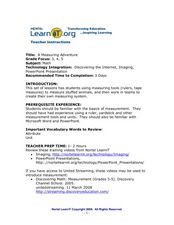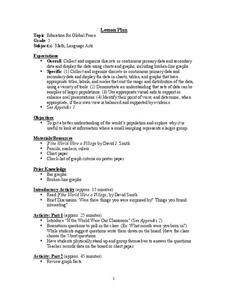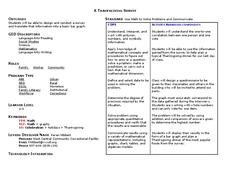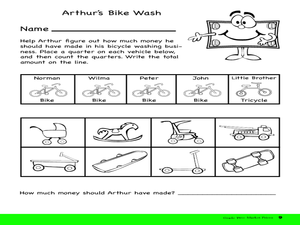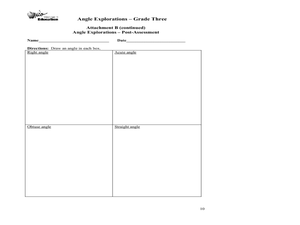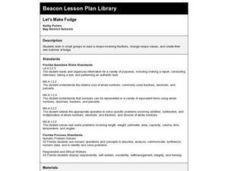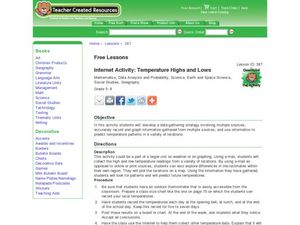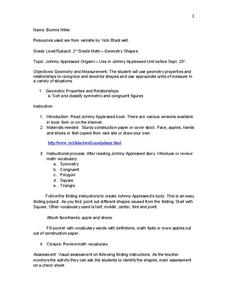Curated OER
A Measuring Adventure
Students practice measuring items. In this measurement lesson, students read the book Measuring Penny and create their own system of measurement. Students measure various items in the classroom, using their creative measurement system.
Curated OER
Education for Global Peace
Fifth graders construct data graphs based upon sets of data. In this graphing lesson, 5th graders read the text If the World Were a Village and discuss how types of graphs accurately represent a large population. Students construct their...
Curated OER
A Thanksgiving Survey
Students conduct a survey. In this math lesson, students design and conduct a survey about Thanksgiving foods. Students display the collected data in a graph and use the graph to determine what food to serve for a Thanksgiving meal.
Curated OER
How Much?
Fifth graders problem solve to determine if a fundraiser will be successful in the money raising activity. In this problem solving lesson, 5th graders read a book about fund raising and write down important vocabulary words. Students...
Curated OER
Spending Money
Students complete activities to study the value of money. In this money study lesson, students read a story about money and discuss how they earn money at home. Students watch a related video clip and create a class book about the ways...
Curated OER
Saving Money
After listening to the wonderful book, A Chair for my Mother, young mathematicians engage in an awesome lesson about coins and the value of saving money. The lesson is done in a classic style - everything is beautifully organized, and...
Curated OER
Market Prices
Second graders understand that prices change. In this business, price and labor lesson, 2nd graders define the words market and price. Students read Arthur's Funny Money and answer questions related to earning and spending money....
Curated OER
Angle Explorations
Third graders observe angles in their classroom and create an angle finder to represent them.In this angles lesson plan, 3rd graders classify angles as acute, obtuse, right or straight. Students find the differences and similarities in...
Curated OER
Let's Make Fudge
Students make fudge after reading fractional values in recipes and finding equivalent fractions to those presented in the recipes. They study measurement abbreviations.
Curated OER
First Rhythmic Composition
Students apply fractions to counting rhythm in music. In this algebra lesson, students interrelate the concept of math into music as they fill out a chart identifying the names and symbols of music notes and their equivalent values in...
Curated OER
Temperature High and Lows
Young scholars gather high and low temperature readings through email. In this temperature graphing lesson, students use a spreadsheet to input data for a graph. young scholars interpret the graphs to compare and contrast the data from...
Curated OER
I Want It All!
Third graders understand the economics of choices in buying. In this goods and services lesson, 3rd graders participate in activities to make choices about purchases. Students write stories, answer questions, and complete worksheets to...
Curated OER
Characteristics and Functions of Money
Fourth graders discuss the function and characteristics of money. In this financial education lesson plan, 4th graders read the book The Go-Around Dollar by Johnston Adams. This book sparks a conversation on how money is used and the...
Curated OER
Saving and Investing
Fifth graders participate in activities to promote understanding of investing and saving. In this saving and investing lesson, 5th graders design a portfolio, play a card game and write a skit about the importance of investing.
Curated OER
Bar Graphs
Students perform operations and graph their data using charts and bar graphs. In this algebra lesson, students follow specific steps to make a bar graph. They create a survey about people favorite things and plot their data from the...
Curated OER
Making Choices
Second graders explore financial decision making. In this introductory economics instructional activity, 2nd graders listen to the book Alexander, Who Used to be Rich Last Sunday by Judith Viorst, and discuss making financial choices...
Curated OER
Johnny Appleseed Origami
Second graders make an origami Johnny Appleseed. In this geometry lesson students follow folding instructions. They find different geometric shapes while they are folding. They create Johnny Appleseed's body and attach a face and hands...
Curated OER
Analyze The Learner; Chocolate Fractions
Third graders describe, represent and compare fractions using pieces of a chocolate bar. In this fractions lesson, 3rd graders demonstrate how to read and write fractions correctly. Students then integrate technology by using...
Curated OER
The Wolf's Chicken Stew 100th Day Celebration
Students celebrate 100 by reading Keiko Kasha's, The Wolf's Chicken Stew, graphing, and making 100 pancakes.
Curated OER
Money Versus Trade
Students discover the importance of exchanging money in a market. In this economics lesson, students discover natural resources and how one can barter with those resources. In addition, students complete worksheets and discover the...
Curated OER
Government Goods and Services
Fifth graders investigate the connection between taxes and government services. In this economics lesson plan, 5th graders discuss the process and benefits of paying sales and income taxes. Using calculators, students compute...
Curated OER
Why Would I Owe My Soul to the Company Store?
Sixth graders listen to "Sixteen Tons" by Tennessee Ernie Ford and discuss what it means to owe one's soul to a store. In this mathematics lesson, 6th graders determine what a miner's income was minus his expenses graphing findings in a...
Curated OER
A Small Book of Small Things
Students explore size relationships as they collect pictures of the small things in their world. In this early childhood math and literacy lesson, students gain an understanding of size differences and develop fine-motor and literacy...
Curated OER
Buttons, Buttons, Everywhere!
Students compare, sort, and describe shapes. Using a button collection, students identify the shape, color number of holes, etc. Students play a description game with the buttons. They create a chart and name items that are the same...
